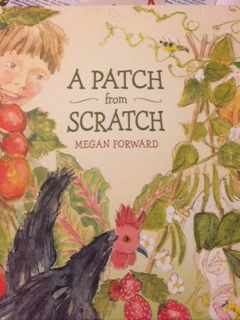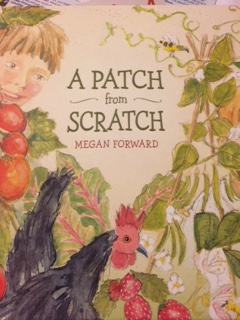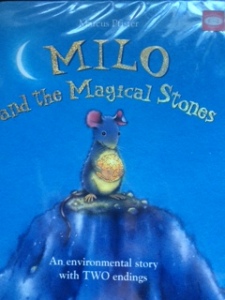A patch from Scratch written by Megan Forward.

This book reminds me of my own little family and I am sure many other families who live in the suburbs of large cities! We have had lots of fun (and still do) in our backyard thinking of ways that we can make our yard a mini farm. We have chickens, compost bin, worm farm and a veggie patch and although it is a bit of work to maintain it is a great reward to have our own eggs and vegetables right in our own backyard.
A patch from scratch is written from the perspective of a young child, which I think really empowers young readers to think – how can I do this in my own backyard? The illustrations show how the family make the different items needed for their own backyard farm and offer some simple tips throughout.
This is a cleverly written book, giving readers insight into how they can create their own veggie patches, chicken coops and compost bins. It shows that growing your own food can be fun and rewarding without being too much hard work.
But what about those who live in apartments? Children who live in these places may feel like they cannot connect to this book – but they can! Many suburbs now have community gardens so search your area for one. Your child’s school or daycare may also have a small patch that they can be a part of.
There are many mini compost bins you can buy that can sit on balconies and mini herb patches where you can grow your own herbs. Be creative, getting in touch with dirt and plant growth is vital so that young people understand where food comes from – not just a supermarket!
Watch this great Ted talk by Jamie Oliver : https://www.ted.com/talks/jamie_oliver?language=en
This is a great book, and one that we have enjoyed reading over. We have spent time looking at the illustrations as we have read the words and noticed the fun the family in the story are having. A great read that can be enjoyed by the whole family!
So what can you do to link this book to the curriculum?
Science
Life Cycles
- Find out about the life cycle of a chicken. Extend this into other animals that we eat and other animals that we eat the produce of.
- Can you compare two of these animals?
- To extend research how different countries harvest honey, what they feed their cows or how they eat different meat.
- Can all plants grow in your area? Research which plants grow best in your area. When to plant them and where they grow best in the garden.
Science – insects
- Research Australian stingless bees. Where do they live? How do they collect honey? How do they move about? Compare the different types of stingless bees in Australia. Find out why their hive is designed the way it is.
Literacy
Descriptive texts
- Imagine you are in charge of creating a new patch for your backyard. You may have a little bit of magic up your sleeve – how can this help you to grow delicious food and perhaps some food that hasn’t been eaten in years (due to it’s unpopularity) Link here to look at heirloom seeds and the Diggers club.
Informative texts
- Write a report about how to grow a vegetable or fruit of choice.
- Create your own plant diary like the child did in the story. Grow a seed of choice and record how it grows in different locations and with different amounts of sun, water and love.
Persuasive texts
- Write a letter to your local Councillor outlining why there needs to be more veggie patches in your community. Suggest how this could happen (free compost bins, land for a community patch, gardening workshops etc)
Mathematics
- Give students a designated backyard space in which they need to design their own sustainable backyard. They can be given budgets, time constraints and must have items.
- Work out which plants and how many can grow in a designated area. Different vegetables and fruits need space so work this out and then apply to a patch of dirt.
Curriculum links
Science
Early Stage One
Living things have basic needs, including food and water (ACSSU002)
Stage One
People use science in their daily lives, including when caring for their environment and living things (ACSHE022)
Stage Three
Calculate perimeter and area of rectangles using familiar metric units (ACMMG109)
Solve problems involving the comparison of lengths and areas using appropriate units (ACMMG137)
Sustainability
OI.6 The sustainability of ecological, social and economic systems is achieved through informed individual and community action that values local and global equity and fairness across generations into the future
Instagram: Flickingonthebook
Twitter: Vanessaryanr
Facebook: Flicking on the book


